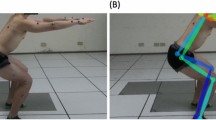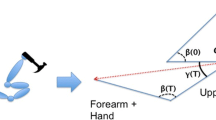Abstract
Ergonomics plays an important role and has contributed to sustainable development in many areas such as product design, architecture, health, safety, and workplace design. An ergonomic assessment is a crucial task in real workplace environments to prevent potential musculoskeletal disorders. Recently, visual ergonomic assessment has been widely utilized for skeleton analysis of human joints for body posture identification to deal with musculoskeletal disorders risks. However, posture identification has limitations in self-occlusion joint postures. This study presents a visual ergonomic assessment approach for posture identification in free- and self-occlusion conditions. For self-occlusion detection, as the main focus of this study, an algorithm is proposed to overcome this limitation to detect the joints’ location when other relative joints block the joints. After the self-occlusion is detected, the location of a blocked joint is identified using the primary data collected in body data extraction in the joint location estimation process. Then, the identified location of the joint is used for posture identification in the free and self-occlusion detection process. The posture identification is based on the OWAS standard for posture and category identification. Finally, experimental results and performance evaluation are presented in individual and integrated procedures. In individual evaluation, the performance of the algorithm is reported for the self- and free-occlusion detection, posture, and category identification processes separately. The results are collected for the overall proposed approach in integrated evaluation, and the performance is measured using standard evaluation metrics. As experimental results show, the proposed approach can effectively detect the postures and identify the associated category in the OWAS standard for both self- and free occlusions.





Similar content being viewed by others
Data availability statement
Data will be available on request.
References
Aghamohammadi A et al (2018) A parallel spatiotemporal saliency and discriminative online learning method for visual target tracking in aerial videos. PLoS ONE. https://doi.org/10.1371/journal.pone.0192246
Allahyari T, Sahraneshin Samani A, Khalkhali H-R (2016) Validity of the Microsoft Kinect for measurement of neck angle: comparison with electrogoniometry. Int J Occup Saf Ergon. https://doi.org/10.1080/10803548.2016.1219148
Balogh I et al (2004) Self-assessed and directly measured occupational physical activities—influence of musculoskeletal complaints, age and gender. Appl Ergon 35(1):49–56
Blumrosen G et al (2016) A real-time kinect signature-based patient home monitoring system. Sensors 16(11):1965
Brandl C, Mertens A, Schlick CM (2017) Effect of sampling interval on the reliability of ergonomic analysis using the Ovako working posture analysing system (OWAS). Int J Ind Ergon 57:68–73
Burdorf A, Laan J (1991) Comparison of methods for the assessment of postural load on the back. Scand J Work Environ Health 17(6):425–429
Chander DS, Cavatorta MP (2017) An observational method for postural ergonomic risk assessment (PERA). Int J Ind Ergon 57:32–41
Chiasson M-È et al (2015) Influence of musculoskeletal pain on workers’ ergonomic risk-factor assessments. Appl Ergon 49:1–7
Chowdhury SS, Boricha J, Yardi S (2012) Identification of awkward postures that cause discomfort to Liquid Petroleum Gas workers in Mumbai, India. Indian J Occup Environ Med 16(1):3
Clark RA et al (2012) Validity of the Microsoft Kinect for assessment of postural control. Gait Posture 36(3):372–377
David GC (2005) Ergonomic methods for assessing exposure to risk factors for work-related musculoskeletal disorders. Occup Med 55(3):190–199
Deros BM et al (2016) Ergonomic risk assessment on oil palm industry workers. Iran J Public Health 45(1):44–51
Diego-Mas JA, Alcaide-Marzal J (2014) Using Kinect™ sensor in observational methods for assessing postures at work. Appl Ergon 45(4):976–985
Dutta T (2012) Evaluation of the Kinect™ sensor for 3-D kinematic measurement in the workplace. Appl Ergon 43(4):645–649
Fığlalı N et al (2015) Image processing-aided working posture analysis: I-OWAS. Comput Ind Eng 85:384–394
Heiden M et al (2019) Validity of a computer-based risk assessment method for visual ergonomics. Int J Ind Ergon 72:180–187
Hignett S, McAtamney L (2000) Rapid entire body assessment (REBA). Appl Ergon 31(2):201–205
Hoy J et al (2005) Whole body vibration and posture as risk factors for low back pain among forklift truck drivers. J Sound Vib 284(3):933–946
Institution of Occupational Safety and Health (IOSH), UK (2009) Ovako Working posture Assessment System (OWAS). https://iosh.com/media/1692/owas.pdf. Accessed 10 Mar 2022
Karhu O et al (1981) Observing working postures in industry: examples of OWAS application. Appl Ergon 12(1):13–17
Kee D, Karwowski W (2001a) LUBA: an assessment technique for postural loading on the upper body based on joint motion discomfort and maximum holding time. Appl Ergon 32(4):357–366
Kee D, Karwowski W (2001b) The boundaries for joint angles of isocomfort for sitting and standing males based on perceived comfort of static joint postures. Ergonomics 44(6):614–648
Kowalski K et al (2012) Direct and indirect measurement of physical activity in older adults: a systematic review of the literature. Int J Behav Nutr Phys Act 9(1):148
Li G, Buckle P (1999) Current techniques for assessing physical exposure to work-related musculoskeletal risks, with emphasis on posture-based methods. Ergonomics 42(5):674–695
Lun R, Zhao W (2015) A survey of applications and human motion recognition with Microsoft Kinect. Int J Pattern Recognit Artif Intell 29(05):1555008
Luttmann A et al (2003) Preventing musculoskeletal disorders in the workplace. World Health Organization, 4(1):1-40
Makhbul ZKM et al (2011) Ergonomics and work stress issues in banking sector. Aust J Basic Appl Sci 5(9):1301–1309
Manghisi VM et al (2017) Real time RULA assessment using Kinect v2 sensor. Appl Ergon. https://doi.org/10.1016/j.apergo.2017.02.015
Mattila M, Karwowski W, Vilkki M (1993) Analysis of working postures in hammering tasks on building construction sites using the computerized OWAS method. Appl Ergon 24(6):405–412
McAtamney L, Nigel Corlett E (1993) RULA: a survey method for the investigation of work-related upper limb disorders. Appl Ergon 24(2):91–99
Müller B et al (2017) Validation of enhanced Kinect sensor based motion capturing for gait assessment. PLoS ONE 12(4):e0175813
Nawi NSM et al (2016) Malaysian oil palm workers are in pain: Hazards identification and ergonomics related problems. Mal J Public Health Med 16(Suppl 1):50–57
Openshaw S, Taylor E (2006) Ergonomics and design a reference guide. All Steel Inc., Iowa
Park Y, Moon S, Suh IH (2016) Tracking human-like natural motion using deep recurrent neural networks. arXiv preprint arXiv:1604.04528
Plantard P et al (2015) Pose estimation with a Kinect for ergonomic studies: evaluation of the accuracy using a virtual mannequin. Sensors 15(1):1785
Plantard P et al (2016) Validation of an ergonomic assessment method using Kinect data in real workplace conditions. Appl Ergon. https://doi.org/10.1016/j.apergo.2016.10.015
Pterneas V (2017) Measuring Kinect joint rotations. Available from: https://vitruviuskinect.com/kinect-joint-rotations. Accessed 5 Apr 2022
Radjiyev A et al (2015) Ergonomics and sustainable development in the past two decades (1992–2011): research trends and how ergonomics can contribute to sustainable development. Appl Ergon 46:67–75
Rodrigues PB, Xiao Y, Fukumura YE, Awada M, Aryal A, Becerik-Gerber B, Roll SC (2022) Ergonomic assessment of office worker postures using 3D automated joint angle assessment. Adv Eng Inform 52:101596
Roman-Liu D (2014) Comparison of concepts in easy-to-use methods for MSD risk assessment. Appl Ergon 45(3):420–427
Rosário JLPd (2014) Biomechanical assessment of human posture: a literature review. J Bodyw Mov Ther 18(3):368–373
Shotton J et al. (2011) Real-time human pose recognition in parts from single depth images. in Computer Vision and Pattern Recognition (CVPR), 2011 IEEE Conference on. Ieee
Syazwani MN et al (2016) Ergonomic risk assessment of manual handling tools by oil palm collectors and loaders. Mal J Public Health Med 16:56–60
Team M (2018) Microsoft Documentation. FloorClipPlane Property 2018. Available from: https://msdn.microsoft.com/en-us/library/windowspreview.kinect.bodyframe.floorclipplane.aspx. Accessed 24 Mar 2022
Tee KS et al. (2017) A study on the ergonomic assessment in the workplace. in AIP Conference Proceedings. AIP Publishing LLC
Valero E et al (2016) Musculoskeletal disorders in construction: a review and a novel system for activity tracking with body area network. Appl Ergon 54:120–130
van der Beek AJ et al (2005) An evaluation of methods assessing the physical demands of manual lifting in scaffolding. Appl Ergon 36(2):213–222
Vieira ER, Kumar S (2004) Working postures: a literature review. J Occup Rehabil 14(2):143–159
Wang Q et al. (2015) Evaluation of Pose Tracking Accuracy in the First and Second Generations of Microsoft Kinect. in 2015 International Conference on Healthcare Informatics
Wiktorin C, Karlqvist L, Winkel J (1993) Validity of self-reported exposures to work postures and manual materials handling. Scand J Work Environ Health 19(3):208–214
Xu X, McGorry RW (2015) The validity of the first and second generation Microsoft Kinect™ for identifying joint center locations during static postures. Appl Ergon 49:47–54
Zennaro S et al. (2015) Performance evaluation of the 1st and 2nd generation Kinect for multimedia applications. in 2015 IEEE International Conference on Multimedia and Expo (ICME)
Acknowledgements
This work was supported by the Basic and Applied Basic Research Project, Machine Learning-Based Research on Dangerous Driving Behavior (No. 2021-01-01-01-001-0001).
Author information
Authors and Affiliations
Corresponding author
Additional information
Publisher's Note
Springer Nature remains neutral with regard to jurisdictional claims in published maps and institutional affiliations.
Rights and permissions
Springer Nature or its licensor (e.g. a society or other partner) holds exclusive rights to this article under a publishing agreement with the author(s) or other rightsholder(s); author self-archiving of the accepted manuscript version of this article is solely governed by the terms of such publishing agreement and applicable law.
About this article
Cite this article
Li, X. A visual ergonomic assessment approach using Kinect and OWAS in real workplace environments. Multiscale and Multidiscip. Model. Exp. and Des. 6, 123–134 (2023). https://doi.org/10.1007/s41939-022-00133-w
Received:
Accepted:
Published:
Issue Date:
DOI: https://doi.org/10.1007/s41939-022-00133-w




